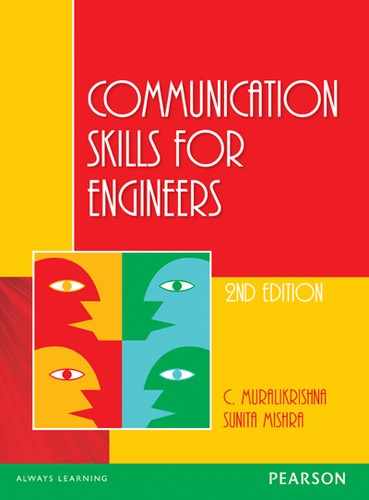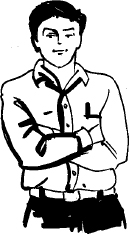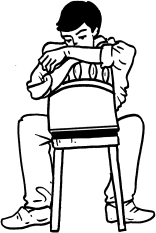CHAPTER 2
Non-Verbal Communication: Body Language
Get in touch with the way the other person feels. Feelings are 55% body language, 38% tone and 7% words
—Anon
This chapter introduces the subject of body language. It discusses the communicating potential of our body along with its gestures. It looks especially into the communicating ability of the face, hands and the feet. The chapter also examines the concepts of distance and positioning, orientation of the body and mirror imaging.
THE COMMUNICATING BODY
Communication, as we have seen before, can be both verbal and non-verbal. If verbal communication deals with words, sentences or spoken expressions, non-verbal language constitutes body-movements, gestures and facial expressions. In fact, research has proved that only 7% of our communication takes place through words. About 38% of the message is conveyed through the tone, voice and inflection while and non-verbal, physical behaviour accounts for around 55% of our communication. Very often, body language is unintentional and involuntary. Ironically, it is these signals that primarily determine the quality of communication, the meaning that is finally read into what we want to say.
Body language forms a very important part of our day-to-day communication. They express our inner feelings, our conflicts and interpersonal attitudes. Often, when we fail to express our feelings in words, a warm handshake or a hug, conveys intimacy much more effectively and powerfully. Similarly, loss of eye contact, yawning, or slumping in the chair can express boredom or loss of interest, even though verbally we still say that we are interested.
Too often we underestimate the power of a touch, a smile, a kind word, a listening ear, an honest compliment, or the smallest act of caring, all of which have the potential to turn a life around.
—Leo Buscaglia
STUDYING BODY LANGUAGE
Discussed below, are three widely studied categories of body language. They are: 1) The facial expressions, 2) Movements and positioning of the hands, 3). Movements and positioning of the legs.
The Face
In any communication situation, the face is generally said to be the most effective indicator of emotions. Most of our reactions as a speaker are dependent on the feedback we get from the face of the listener. Many professionals who directly deal with people like teachers, counselors, doctors, businessmen and artists take a lot of clue from the faces of the person they are dealing with. Researchers have found generally eight basic facial emotions: surprise, interest, joy, rage, fear, disgust, shame and anguish. These are universally found in all cultures. Sometimes, the face may even show a blend of two different emotions like, for example, pleasant surprise, which can manifest as a pleasant smile combined with raised eyebrows.
Given below is a list of the facial expressions and the emotions they suggest.
| a. Surprise or astonishment | - Raised eyebrows. |
| b. Anger or frustration | - Furrowed forehead. |
| c. Displeasure or confusion | - Frowning. |
| d. Antagonism | - Tightening of the jaw muscles or squinting of the eyes. |
| e. Defiance | - Thrusting out of the chin. |
| f. Dislike, rejection or contempt | - Turning up of the nose. |
| g. Extreme shock | - An open-mouthed reaction. (This can also happen if someone is concentrating very intensely. In this case, all the facial muscles below the eyes are completely relaxed and sometimes even the tongue protrudes). |
| h. Aggression | - Here, the eyes will be wide-open and the lips tightly closed. The corners of the eyebrows will be turned down and teeth clenched. |
| i. Disinterest in a deal | - Eyes down-cast with the face turned away. |
| j. Interest | - The opposite can be a relaxed mouth, a smile and a projected chin. This can suggest that a customer is considering a deal and is obviously interested. |
| k. The blank face | - This is the 'dead pan' face or the emotionless face that is completely relaxed. This is a typical reaction when a person is withdrawn, completely into himself or herself. The strong emotional signal that this face sends is, “Do not disturb”. |
Most of the facial reactions we have discussed here are a combination of two or more features. Sometimes a single aspect of the facial expression too can convey a lot.
The head nod: A small head nod generally signifies attention whereas a more vigorous and repeated movement signifies strong agreement with some viewpoint being expressed.
Head movements are generally very significant in communication. If a person shakes his/ her head from side the side but says—“Of course I do agree” or “This is really interesting” one cannot definitely take the words at their face value. The feeling one is left with is that, either the speaker in lying or being sarcastic.
The head tilt: Slight tilt of the listener's head is always seen as a sign of keen listening and interest. The nodding of the head accompanied by the head-tilt position can suggest empathy and complete agreement with the speaker. In contrast, the straight head, more often than not, shows a neutral attitude.
During a lecture session, if heads are not tilted it might be an indication that sufficient interest has not been evoked. If from a head tilt position people move on to a straight position and then begin to slouch, it is a clear indication that there has been too much of information loading and that it is now time to stop.

Head tilt
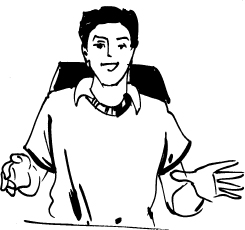
Open hands
The Hands
Our hands are among the most expressive parts of our body during communication. In a big way, they indicate our mental process. Scientists have observed that there is more number of links between our brain and our hands than any other part of the body. They signal our thoughts, show our feelings and our mental state.
Open hands: Open hands are always a sign of trust, a desire to communicate and an invitation to share his/her point of view. Some even believe that it allows positive energy to flow from the speaker to the listeners, making the listeners more receptive to what the speaker is saying.
Upfacing flat hand: A flat hand with the palm facing up or outward is always definitely a silent question. It says, 'why?' or “I don't understand'
Relaxed hands: A calm, confident, self-assured person's hand will definitely be relaxed. The hands would gracefully rest one on top of the other. Even though they are involved in doing something else, their movement will be steady and controlled.

Relaxed hands
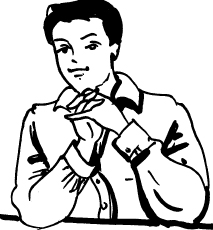
Clenched hands
Restless hands: An uneasy, jittery or nervous person's hands will also be restless and jittery. Even when apparently calm, the hands can be restlessly picking, scribbling, biting or even sucking. Such movements show anxiety or a lot of nervous energy.
Clenched hands: Invariably, clenched hands are a sign of negative emotion. In different contexts, they signify different emotions. Sometimes, they signify a feeling of tension and frustration (a feeling of being tied down). During negotiations, they can even signify a closed mind, a persons who will no longer accept suggestions or see your point of view. Clenched hands with the rubbing of the thumb or picking the cuticle of one thumb, sometimes shows need for reassurance. They signify a nervous, uncertain mind, unable to resolve a problem.
Clinging hands: Sometimes, when we cling to the armrest of the chair, a table, files or books, we indicate insecurity, or nervous anxiety.
Wringing hands: Pressing, twisting and squeezing of one hand with the other is again a sure sign of discomfort, feeling of insecurity or need for reassurance.
The Arms
Crossed Arms: Crossed arms form a kind of barrier, a guard against perceived threat. It can be seen as a defensive posture. Sometimes, it may even mean that the person being spoken to has a closed mind to the topic being spoken. He/she is determined to take up a certain stance and is subconsciously bracing up against any opposition.
Crossed arms
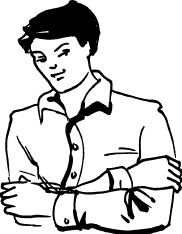
Arm gripping
The gesture also stands for relaxation. It can be seen as a way of resting the arms. However, generally it has also been seen that the person who takes up this posture is less likely to listen or accept the viewpoint of others. In a group, generally, people who have their arms relaxed by their sides are more likely to be ready to listen, accept or understand.
Arm gripping: Arm gripping, similarly is seen as a negative attitude. In this posture the hands grip the upper arms tightly to prevent their sliding down to a relaxed position. More often than not, this posture shows a negative, suppressed attitude. It signifies fear or sometimes depression. This also is a subconscious protective posture the body assumes when there is any psychological threat or perception of insecurity.
Arms behind the back: If a person tightly clenches his fist behind his back or tightly holds the wrist of one hand, it either shows that he/she is trying to disguise emotions or facing inner conflict. The same gesture – arms at the back – but with unclenched hands can, on the other hand, show superiority and confidence.
Unconsciously, here, the person has exposed his vulnerable areas like throat, heart and stomach. The gesture thus shows fearlessness, authority and easy confidence.
Apart from these basic kinds of hand and arm movement, there are numerous hand-to-face gestures that signify certain moods or attitudes.

Arms behind the back

Hand covering mouth
Hand covering the mouth: This gesture might show that the person is lying, trying to hide a feeling, or deliberately not expressing his views.
Putting something in the mouth: This is done in many ways. A person may bite his nails, put pens, pencils or even the arms of spectacles into his mouth. All these are seen as movements that show the need of reassurance. They can indicate anything from nervousness, indecisiveness and anxiety to a decision-delaying tactic.
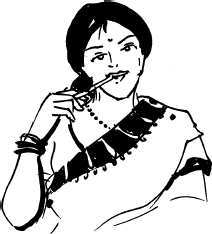
Putting something in the mouth
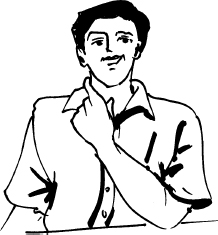
Scratching the neck
Scratching the neck: A sustained scratch accompanied by the person looking down or away could mean that he/she is searching his/her memory. Scratching the neck just below the ear lobe lightly, would mean uncertainty. It shows discomfort.
Neck stroking: This is more often found in women. They stroke the neck or feel the necklace. It would mean disbelief, discomfort or even signify indecisiveness or a decision making process.
Rubbing the eye: Shutting the eye with a finger or rubbing the eyes during a conversation could mean that the person is in doubt or is trying to deceive.

Rubbing the eyes

Rubbing the nose
Rubbing the nose: Rubbing or touching the nose slightly during a conversation might be a sign of rejection or a gesture of doubt.
Hand behind the back of the head: This is a gesture that signifies confidence, dominance or a feeling of superiority. Often people are found assuming this posture during conversation with their subordinates but is done rarely in the presence of their superiors. It is a typical gesture that means “Everything is under control”.

Hands at the back of the head
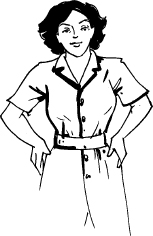
Hands on hips
Hands on hips: This is a gesture that could show aggressiveness or a non-verbal challenge. Very often, however, it shows readiness for action, readiness to take up or tackle targets. Sometimes, people adopt this posture to appear bigger, more powerful or dominant.
The Legs
The placing and positioning of the legs too, play an important role in body language. Given below are some of the big postures we commonly make.
Cross-leg gesture: This is a gesture when the legs are crossed, with one knee resting on the thigh of the other. It is generally done when a person is occupying a chair, sitting in the same uncomfortable position for a long time. Variation of this posture is one leg crossed almost horizontally, with the ankle resting on the other knee. Like the crossed hand position, both these positions show a defensive attitude. The person might be nervous, withdrawn, or geared up to face a perceived threat. It is generally observed in meetings that when there is a discussion or negotiation many of the participants will cross their legs. When an agreement is reached, and the issue has been amicably settled, many of them will most probably uncross their legs and move or tilt towards one another. Generally, it may be concluded that crossed legs signify defensiveness, a propensity to not accept the other viewpoint. Uncrossed legs, on the other hand, show a more receptive frame of mind, in tune with what the speaker is proposing. If the crossed-legged position is coupled with the crossed hand position, the resistance is definitely intense. In a meeting or during discussions, this is most surely a sign that there is an argument or resistance ahead.
Crossed legs with the foot moving in small kicking motion, again, signify boredom in a given situation. This, combined with the foot pointing towards the exit is a clear sign that the person wants to leave the place.
While analyzing crossed legs, however, one has to be a little careful. In Europe, for example, women are expected to sit with their legs crossed or tightly held together. Etiquette demands it. In this context, therefore, it need not be inferred that the women are defensive or in a mood to disagree.
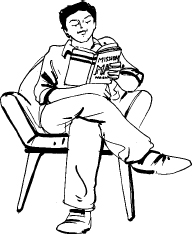
Crossed legs
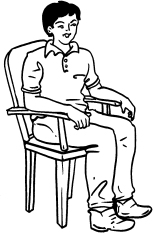
Relaxed sitting pose
Sitting Styles
The relaxed sitting pose: Sitting in a chair with legs relaxed and apart, the hands resting flat on the arms of the chair signifies an open, relaxed attitude. Two people sitting in this posture facing one another and discussing, is definitely a sign that the two are in tune with one another's thought. There is hardly any disagreement or resistance.
Sitting on the edge of the chair: From a relaxed sitting posture, moving to the front of the chair can signify that the people involved are ready to compromise, co-operate or agree. Sometimes, it can even signify that the people are ready to finally reject and abandon the discussion. Sitting forward in a chair with feet on the tiptoe shows readiness for acceptance, readiness for action.
Sometimes, when sitting on the edge of the chair is accompanied by stiff hands placed on the knees or gripping the sides of the chair, it can signify fear, tension or a desire to be free from the situation. This is generally coupled with very tense facial expression.
Leg over the arm of the chair: Apparently, a person with the leg over the arm of the chair appears relaxed and informal, in a mood to enjoy. But sometimes, the posture can also be taken to signify a defensive attitude saying '“I don't care!”. It can denote indifference, hostility and sometimes a dominant, superior attitude.
Straddling the chair: Sitting with the chair around so that its back faces the people one is talking to can signify an informal, relaxed mood. In a different context, however, it could even signify a defensive mood, an attempt to shield or protect oneself against imagined hostility. A straddle can show aggression, especially when faced with resistance or bored with the conversation. In such a context, turning around and going to the back of the person one is talking to can make the latter feel vulnerable. And most probably he/she will turn around to face the speaker, if it is a swivel chair.
Straddling the chair
DISTANCE AND POSITIONING
In our day-to-day life, very often our attitude is signified by the spaces we occupy – both in relation to others or ourselves. We stand in particular places, occupy particular chairs and maintain specific distances vis-à-vis specific people. Space or distance can, in general, be divided into these broad categories.
Intimate distance: Each of us guards our own territory. We allow only certain people into very close proximity. This could be from real physical contact to about six inches from our body. This distance we reserve only for people with whom we are emotionally close. It could include one's child or parent, close friends, relatives or a lover. Here, the sense of physical proximity is intense. But visibility is low.
Personal distance: This, too, is a relatively close distance zone. It involves a certain area a person reserves around oneself. In case of informal, outgoing people, this distance might be less. Stiff and reserved people however might maintain a larger area as their personal distance. This is typically the space within which a person maintains privacy or social intimacy. This distance becomes obvious in social gatherings or parties. Sometimes two or more people gather in a public place but get together within one another's personal zone. This is in striking contrast to the longer distance which people maintain with others with whom they don't feel particularly close.
Social distance: This is the distance we maintain with people we interact, but don't know very well. It could be a new employee, a colleague or sometimes people staying in the same neighborhood. The distance could be between four to seven feet depending on whether it is a close or distant social contact. People with a firmly established hierarchical relationship also generally maintain this kind of distance.
Public distance: This could be a distance between twelve and twenty five feet -- a distance suitable for lectures or conferences. Such distance is also maintained by politicians while addressing people and by actors on the stage.
BODY ORIENTATION
Sometimes, the way we stand in relation to one another also shows our attitude and frame of mind. Two people with the upper part of the body inclined towards one another definitely means agreement. The distance between the two people could suggest how close or far they are but they definitely agree or at least are tuned to one another's thought process. When two people maintain a right angle and talk without facing one another, it is definitely not a private conversation. The topic could be routine instructions in an office or a discussion that does not closely concern either. When two or three people are discussing something intimate or private they will most probably face one another squarely or form a close triangle. The bodies also might be inclined towards one another. The clear sign here is: “This is a closed meeting–keep off”.
Pointing
The direction towards which a person points his feet or his torso is again a very significant pointer to his/her attitude. Feet pointing at the door could suggest a desire to leave. Sometimes, pointing your feet at someone might even suggest that we are interested in the person. In a party, if a man points his foot at a woman, it might mean he is interested in her. She might, in turn, move close to another person signaling her preference.
Mirror Imaging
This is a situation where people mirror or imitate one another's body positioning. After a meeting or during a break if we find two people chatting, mirroring one another's body posture, it is definitely a sign that they agree with one another. Each is receptive to the other's ideas. If in between, one of them suddenly changes his/her position, touches the nose with a finger or looks away, it could be a sign that the rhythm has been broken. Disagreement has cropped in and they are trying to negotiate a problem.
Mirror imaging can be particularly helpful in situations like interviews or a negotiation table. The person whose posture you mirror gets a subconscious feeling of comfort in your presence. It might even make her more inclined to agree with you, accept you and your views. But be careful to do it subtly, delicately. Obvious imitation, which the other person can see and observe, can be seen as a mockery or even as trying to make the other person feel uncomfortable.
Body language is definitely a very important pointer to our attitude, our feelings and emotions. It is important, however, to remember that body language should be considered as a cluster. While studying body language, one should take into consideration the facial expression, the hand, the leg movement and even the context and culture one is operating in. Our experience as social beings does equip each of us to read and recognize body language to a large extent. Often, we have a “feeling” that a person is lying. In spite of talking in a friendly manner, we “think” that he has suppressed hostility towards us. “Instinctively”, we know that two people are intimate and we move out of their personal zone. Sometimes, we also “know” that we are being ignored or we are unwanted in a group.
A mother definitely “knows” when a child needs reassurance even though nothing is said. In intimate relationships again, we know exactly whether the person we love is tuned to us or not. Most of this knowledge, we pick up subconsciously from the people around. Some of it could also form part of our genetic memory because even newborn babies have been found to respond to and understand body language. Good communicators, instinctively, understand more of others' body language and respond to it appropriately. It is important for each of us, therefore, to cognize body language as an important part of communication, accept the feedback it gives us continuously and adapt ourselves accordingly.
ACTIVITIES
- Given below are some typical behaviour traits in column by A and some expressions that can match them in column by B. Try to identify what expressions can match with the traits listed.
Column A Column B 1. Turning up the nose a. I don't believe you. I think it is impossible. 2. Cracking the knuckles b. I'm energised. I'm ready. 3. Rubbing the nose c. I want to be honest with you. 4. Sitting on the edge of the chair d. I want to emphasize this point. I'm determined. 5. Crossing the arms at the chest e. I dislike this dish. I reject your opinion. 6. Putting the feet on the table f. I disagree with you. I have to fight it to the end now. 7. Placing the hands on the hips g. I'm nervous and uncomfortable. I wish I could leave the place. 8. Pointing the index finger h. I'm bored now. I want to go on to the next item on the agenda. 9. Placing both palms on the chest. i. I'm indifferent. I don't care about what you are saying. 10. Shrugging the shoulders j. I'm the boss here - After you have matched the columns, build a small monologue around each emotion expressed and enact it
- Given below is a role-play that involves the expression of various emotions. After the role-play is completed, analyze each of the characters and the range of emotions they expressed. Try to remember the body language and the postures that helped them to express these emotions.
Role-Play
The Situation: This is a joint family where the grandfather and the grandmother (Krupa Shankar and Rukmini) stay with their son and daughter-in-law (Aditya and Shanta) and their six-year-old daughter (Priya). The problem has started because, of late, both the father and the mother of the child have started feeling that the grandparents have been pampering the child and that she is getting to become increasingly demanding. There has always been a little tension between the father and son because Aditya felt that his father was very strict in bringing him up and had insisted on his taking up engineering in spite of his desire to take up acting as a profession. The following is a rough description of their characters.
Role Descriptions
Krupa Shankar (grandfather)
You are 68 years old, a retired professor, who always believed in the merits of discipline and hardwork. You sincerely believe that you have done the best for your son.
A career in acting would have been too risky for him and he was not academically motivated enough to get into teaching. In your granddaughter, however, you see a new kind of possibility. With the widening of career possibilities you think she has a great future. You feel she is a brilliant child who should be allowed to choose what she wants in life. Also, you have a nagging guilt in your mind for having stopped your son from taking up his acting career. You would like to compensate by encouraging Priya to follow her heart.
Rukmini (grandmother)
You are almost 65 years old, tired and exhausted with life. You have had an active career and you strongly believe that parents should have the sole deciding authority about their children's future. You are fond of both your son and daughter-in-law, but also detached enough not to be too involved with their life. You feel that Priya should have her own freedom in life, but you don't want to impinge on your son's parenting style.
Aditya (son)
You are 38, a dynamic successful, upcoming engineer. You enjoy all that your present career has given you but you still nurse a secret wound for not being able to take up a career in acting. You resent the fact that your father was once upon a time very strict with you, and you would like to oppose whatever he says or believes. You too think that Priya should have the freedom to be herself, but you want her to be more disciplined and time-conscious. You feel that your father's pampering is encouraging her to be wild and unfocussed.
Shanta (mother)
You are 32, a young lady with your own business enterprise. You feel both your father-in-law and husband are imposing their own ideologies on your daughter. You feel they should just let her enjoy her childhood. Of late, you have been worried about your father's failing health and you are irritated with the constant discourse about your daughter's future.
All of you are sitting together one evening, having tea after a hard day's work. Suddenly, Priya runs in, topples over a cup, breaks it and runs out. Even before you understand, an argument breaks out between father and son. You and your mother-in-law too are dragged into it.
Now analyze the characters along the following lines.
Krupa Shankar
| Dominant emotional traits | corresponding body language |
| 1. | |
| 2. | |
| 3. |
Rukmini
| Dominant emotional traits | corresponding body language |
| 1. | |
| 2. | |
| 3. |
Shanta
| Dominant emotional traits | corresponding body language |
| 1. | |
| 2. | |
| 3. |
Aditya
| Dominant emotional traits | corresponding body language |
| 1. | |
| 2. | |
| 3. |
SUMMARY
- Non-verbal language constitutes body movements, gestures and facial expressions.
- Non-verbal, physical behaviour accounts for around fifty-five per cent of our communication.
- When we fail to express our feelings, a warm handshake or a hug conveys intimacy much more effectively and powerfully.
- Loss of eye contact, yawning or slumping in the chair can express boredom or loss of interest, even though verbally we may still say we are interested.
- The face is a very powerful indicator of our feelings. Professionals like teachers, counselors, doctors, businessmen and artists take a lot of clue from the faces of the person they are dealing with.
- At times, the face shows a blend of two different emotions, like for example, pleasant surprise. It can show as a pleasant smile combined with raised eyebrows.
- Hands play an important role in communicating feelings. Scientists have observed that there is more number of links between our brain and our hands than any other part of the body.
- The placing and positioning of the legs also play an important role in body language.
- In our day-to-day life, very often, our attitudes are signified by the spaces we occupy— both in relation to ourselves or others around us.
- Intimate distance, personal distance, social distance, and public distance are some of the broad space/distance categories.
- Sometimes, the way we stand in relation to one another also shows our attitude and frame of mind.
- The direction towards which a person points his feet or his torso is a significant pointer to his attitude.
- Mirror imaging goes a long way in making the other person comfortable in our presence and to receive our views positively. It can be particularly helpful in situations like interviews or at the negotiation table.
- Effective communicators instinctively understand more of others' body language and respond to it appropriately.
REVIEW QUESTIONS
- In a communication situation, what is the ratio of verbal vis-à-vis non-verbal communication? State in short the various factors involved in communication.
- What are the different kinds of basic emotions expressed by the face? In a situation where a dealer is trying to strike a deal with a client, what are the clues he/she should look for in the face to know the client's reaction?
- What are the different kinds of head movements that matter during communication? State with examples what each of them signifies.
- What are the two kinds of hand movements that can differentiate a calm mind from an agitated restless mind? Give examples and show the differences.
- How would you distinguish between the clenched hand and the clinging hand? In what situation will each of these be used?
- Give a list of body movements that will signify a calm, relaxed and open mind. Explain each of their characteristics in detail and place them in hypothetical situations.
- In a group, the way people sit or stand gives away the proximity they have with one another, the interest they have in what the other is saying. Discuss some of these body-movement clusters.
- Body language should always be studied in a particular context. The same posture, in different contexts can mean different things. Give examples.
- What are the different kinds of distances we observe during communication situations? State the significance of each.
- Each of us is naturally endowed with the capacity to read and analyze body language— discuss.
- What is mirror imaging? State its role in the communication situation.
- Can we always interpret cross-legged gestures to be defensive gestures? Give reasons for your answer.
- How many significations does the 'arms behind the back' posture have? State any two with examples.
- What does 'pointing' mean? What can you infer from a person's feet pointed towards the door?
- What is the difference between 'scratching the neck' and 'stroking the neck'?
